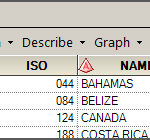
What's the difference between LENGTH and FORMAT in a SAS data set? This article shares the answer, with examples.

What's the difference between LENGTH and FORMAT in a SAS data set? This article shares the answer, with examples.

Use SAS DATA step to split a large binary file into smaller pieces, which can help with file upload operations,

As citizens of the Internet, we are all familiar with IP addresses -- probably more so than our Internet founding fathers had ever intended. These addresses are typically represented in a 4-piece segmented list of numbers separated by dots. Here is an example: "149.173.5.120". Each segment is called an octet

Using relative file paths in your SAS programs? Use the new DLGCDIR function to manage your SAS working directory -- even in SAS Enterprise Guide or SAS Studio -- to ensure your programs are working the way they ought to.

In many movies, there is often a scene where the star says "We can do this the easy way, or the hard way" (and the hard way usually involves quite a bit of pain). So it is with interrogations ... and so it is with writing SAS code! Today I'm

SAS programmers have long wanted the ability to control the flow of their SAS programs without having to resort to complex SAS macro programming. With SAS 9.4 Maintenance 5, it's now supported! You can now use %IF-%THEN-%ELSE constructs in open code. This is big news -- even if it only

With the advent of things like car GPS & Google Maps, and a steady supply of nice maps from certain news sources (such as the New York Times), people have finally embraced the idea that mapping data can be very useful. And if you are into data visualization, you have

One thing that we have a lot of at SAS: installations of SAS software that we can run. I have SAS for Windows on my laptop, and I have access to many centralized instances of SAS that run on Linux and Windows servers. (I also have access to mainframe SAS,

When it comes to e-mail-based newsletters, I'm of two minds. On one hand, I feel like I receive enough (or maybe too much) e-mail and I'm reluctant to clog up my inbox with more stuff -- especially if it's information that's located elsewhere (such as on that big backup drive

Because I began my SAS career in the Publications division, I like to think that I have a keen eye when it comes to SAS documentation. When I first visited the SAS 9.4 online documentation, I immediately noticed that it had a different look. Examine the image below; can you

When I work on SAS projects that create lots of files as results, it's often a requirement that those files be organized in a certain folder structure. The exact structure depends on the project, but here's an example: /results |__ html |__ images |__ xls |__ data Before you can

The project that I'm currently working on requires several input data tables, and those tables must have a specific schema. That is, each input table must contain columns of a specific name, type, and length in order for the rest of the system to function correctly. The schema requirements aren't

I'm working on a SAS programming project with a large team. Each team member is responsible for a piece of the overall system, and the "contract" for how it all fits together is The Data. For example, I've got a piece that performs some data manipulation and produces several output

Rick posted a tip today about using abbreviations in the SAS program editor window (often referred to as the "enhanced editor"). Defining abbreviations is a great way to save keystrokes and re-use "templates" of code that you've squirreled away. (One of Rick's readers also picked up on the tip, and

I've been working with date-time data on a recent project, and I've come across a few SAS programs that have "opportunity for improvement" when it comes time to create reports. (Or maybe I haven't, and I contrived this entire blog post so that I could reference one of my favorite

As I mentioned in my introductory post about Windows PowerShell, you can use PowerShell commands as a simple and concise method to collect data from your Windows systems -- information that is ripe for analysis within SAS. In this example, I'll show a technique for using a SAS program to

I use Google Reader to keep up with SAS-related conversations on the blogosphere. I thought it would be nice to share the lists of blogs that I follow as "shared bundles". If you also use Google Reader, it will be very easy for you to add these bundles to

While talking to SAS users in Australia earlier this month, I often demonstrated the capabilities of the new Map Chart task in SAS Enterprise Guide 4.3. Creating map charts has never been easier: select your map data source, then select your response data source, and click Run. Voila! You've got

It seems like such a simple problem: how can you reliably compute the age of someone or something? Susan lamented the subtle issues using the YRDIF function exactly 1.0356164384 years ago. Sure, you could write your own function for calculating such things, as I suggested 0.1753424658 years ago. Or you

SAS Enterprise Guide sets values for several useful SAS macro variables when it connects to a SAS session, including one macro variable, &_CLIENTPROJECTPATH, that contains the name and path of the current SAS Enterprise Guide project file. (To learn about this and other macro variables that SAS Enterprise Guide assigns,

As I write this, SAS 9.3 has not yet been "shipped", but its release is imminent. I've already heard many questions about how SAS Enterprise Guide works with the new version, so I decided to write this "Frequently-soon-to-be-asked questions" document to help sort it out. What version of SAS Enterprise

About a year ago (wow, has it been that long?), I posted an example program that lets you report on the contents of a SAS information map. Using my example, you can see the data items, filters, and folder structure within a given information map. Last week a reader posted

We sometimes take it for granted, but the concept of the "SAS library" is just about one of the most awesome aspects of The SAS System. You can give your library a name (a library reference, or libref), tell the system how to get to your data (options on a

SAS-based processes are critical to many organizations, but sometimes the trickiest part of your job falls into one or both of these activities: Getting stuff from the outside world "into" SAS. (Once it's in SAS, as many of you know, the world is your oyster.) Getting the output of your

SAS Enterprise Guide has about 150 options that you can customize in the Tools->Options window. With each release, the development team adds a few more options that have been asked for by customers, and they rarely decommission any existing options. It's getting quite crowded on some of those options windows!

I hope that the following statement is not too controversial...but here it goes: Microsoft Excel is not a database system. That is, I know that people do use it as a database, but it's not an application that supports the rigor and discipline of managing data in the same way

It's a simple task to use SAS to compute the number of weekdays between two dates. You can use the INTCK function with the WEEKDAY interval to come up with that number. diff = intck('WEEKDAY', start_date, end_date); If you want to compute the number of working days between two dates,

SAS Enterprise Guide is best known as an interactive interface to SAS, but did you know that you can use it to run batch-style programs as well? SAS Enterprise Guide has always offered an automation object model, which allows you to use scripting languages (such as VBScript or Windows PowerShell)

Many SAS users love "undocumented features" within SAS software that they have found or heard about. Sometimes they can be really useful, and the fact that they are undocumented adds to the mystique. Some users have written entire conference papers on the subject. After 35 years of evolution, SAS contains

The ODS Graphics Designer allows you to design and build your own statistical graphs in SAS, without having to learn how to program in the new graph template language (GTL). The ODS Graphics Designer is a rich user interface that allows you to design these graphs based upon your own